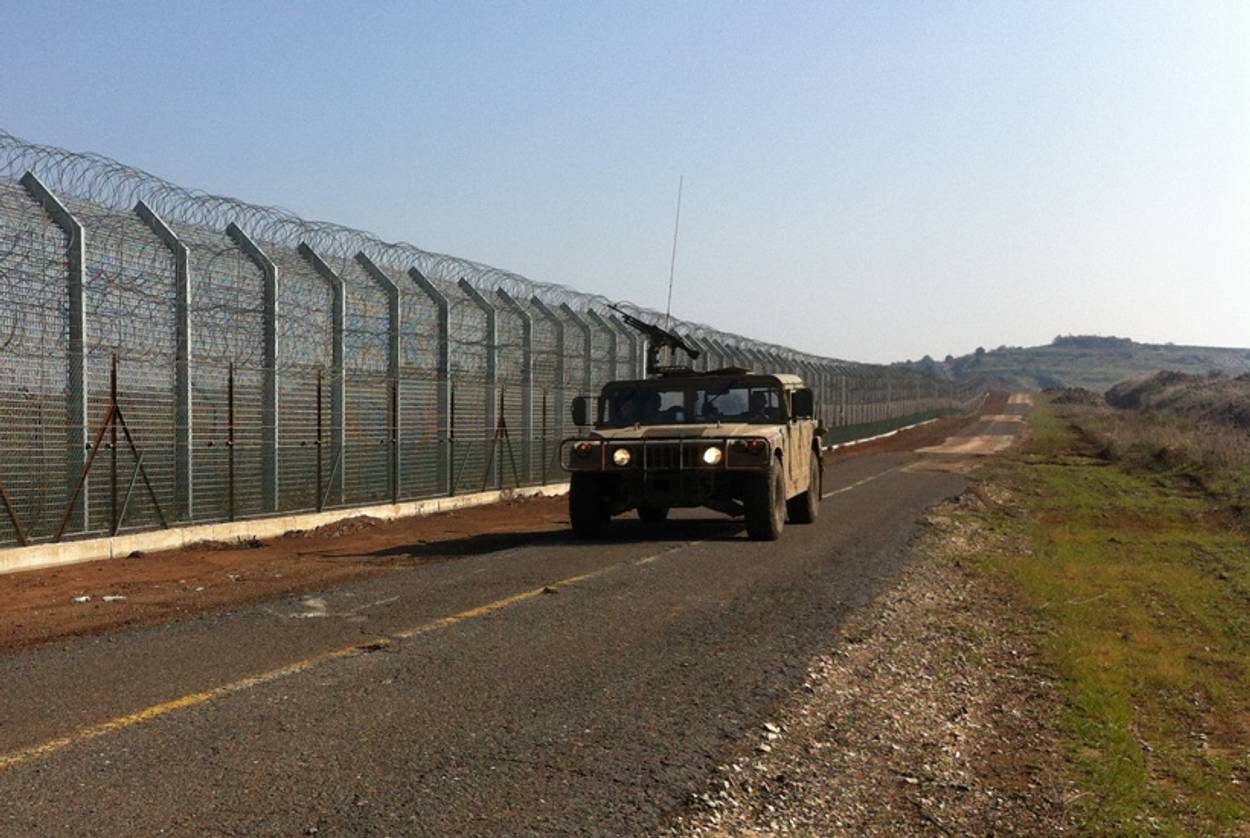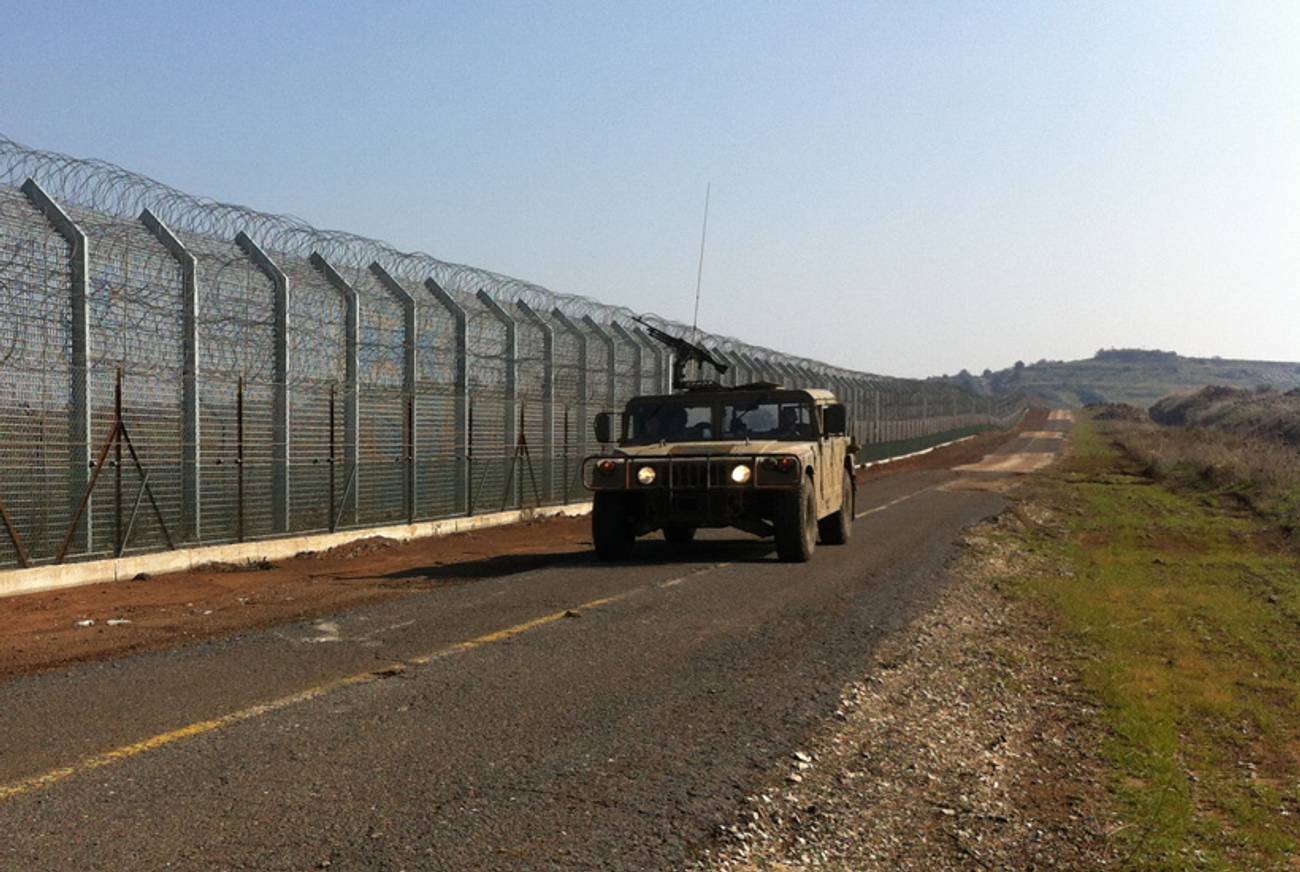In the Golan, Israel Deploys Drones and Steel Fences Against Threats From Syria
At a cost of $75 million, new fortifications stand as physical reminders that peace in the north is further away than ever




Israel’s newest wall snakes along its northern border, long the country’s quietest, climbing over the mountains separating the Golan Heights from Syria and across the grassy hills and plateaus separating it from Lebanon. The barrier, already 60 kilometers long, is made of thick steel pillars and coils of razor-sharp barbed wire, bolstered by some of the most sophisticated cameras, motion detectors, and infrared surveillance equipment in the Israeli arsenal.
The skies over the fence are patrolled by a fleet of unarmed, Israeli-built Sky Rider drones that beam real-time video imagery down to troops on the ground. An Israeli military official boasted that the drones and surveillance equipment allow Israeli forces to “see everything from a shepherd to a runaway sheep.” Every day, the Israeli side of the wall is patrolled by hundreds of active-duty troops who have rushed north in recent months to relieve the reservists who have long been assigned the dull task of securing a border where nothing of note typically happens.
Responsibility for maintaining quiet in northern Israel rests in the hands of men like Lt. Col. Yogev Bar Sheshet, the commander of the infantry battalion with responsibility for a swath of the Lebanese border not yet secured by the new fence. One afternoon last week, Bar Sheshet climbed a ladder onto a concrete escarpment next to a machine-gun nest ringed by sandbags and covered with camouflage netting. The border was less than 10 meters away. To the left were tan buildings housing some of the United Nations peacekeepers stationed along the border; to the right, off in the distance, was a Lebanese army guard tower. A chain link fence topped with a thin strand of barbed wire marked the limit of Israeli control.
Bar Sheshet has been in his job for a year and is convinced that unarmed Hezbollah operatives in civilian clothing are constantly monitoring his base from the other side. “We were always seeing shepherds, but then we noticed that there were three shepherds for every sheep, and they all seemed to be carrying cameras,” he said.
The decision to double the obstacles standing between troops like Bar Sheshet and the threats beyond reflects Israel’s growing concern about the deteriorating situation in the north. Israel believes that Hezbollah has more weaponry in Lebanon than ever before and will turn its firepower onto Israel if their Iranian backers give them the green light. But Israel’s chief worry these days is the escalating civil war in Syria, where President Bashar al-Assad has spent more than two years fighting to maintain his grip on power.
While the world’s attention focuses on the West Bank and the Sinai, Israeli military commanders believe the threat along the Golan border is far more pressing—and, thanks to the infiltration of fighters allied with al-Qaida into Syria, potentially far more dangerous. It’s a marked shift from just three years ago, when a peace deal between Israel and Syria was reported to be a realistic possibility.
Now the new fence is a tangible reminder that the situation in the Golan Heights—which Israel captured in the Six Day War—is unlikely to change anytime soon, if ever.
***
In 2010, the Israeli press and the New York Times reported that Benjamin Netanyahu participated in secret talks with Syria over a comprehensive peace treaty that would have involved a full Israeli withdrawal from the Golan, which Israel annexed in 1981. The talks, according to the Israeli paper Yediot Ahronot, were held at Netanyahu’s official residence in Jerusalem.
The Golan Heights allows Israel to peer deep into Syria and monitor its troop movements. The area also contributes roughly 15 percent of Israel’s water supply. Netanyahu’s willingness to part with the Golan—if his participation in the talks was in earnest—likely would have stemmed from a cool-eyed calculation that a treaty with Syria would lead Assad to break with Iran, leaving Tehran with no Arab allies and making it more difficult for Iran to send weapons and munitions to Hezbollah. Assad, for his part, seemed interested in bolstering his political standing at home by bringing home a prized piece of territory that his father had pursued, unsuccessfully, for decades.
The talks were mediated by a pair of American heavy-hitters: Dennis Ross, a top Barack Obama adviser on the Middle East; and Frederic Hof, an experienced diplomat who had served as the State Department’s special coordinator for Lebanon and Syria. The two sides deadlocked over key details like the timetable for an Israeli withdrawal—Syria wanted full control back within two years, while Israel said it needed more time to dismantle the region’s military bases and towns—but participants have said Netanyahu was fully prepared to cede the entire Golan.
It wouldn’t have been the first time an Israeli prime minister had proposed giving back the territory as part of a peace deal. It wasn’t even the first time Netanyahu did: According to Uri Saguy, the military intelligence officer who conducted talks with the Syrians in 1999 under Ehud Barak, Netanyahu himself held secret negotiations in 1998 with Bashar’s father and predecessor Hafez al-Assad about swapping the Golan for a full peace treaty. Those talks had a cloak-and-dagger element, with Netanyahu using American businessman Ronald Lauder as his personal emissary to Assad. Lauder shuttled back and forth between Damascus and Jerusalem with the proposals and counter-proposals; the Israeli and Syrian negotiating teams never had direct contact. But the talks fell apart, reportedly because the two sides couldn’t fully resolve disputes over water, early-warning stations, and other key details.
The last round of negotiations collapsed when the pro-democracy uprisings of the Arab Spring flared up across the region in early 2011 and quickly spread from Tunisia to Syria and other countries. Assad refused to clearly commit to severing his ties to Iran, making the Israelis worry that an agreement wouldn’t ultimately diminish Tehran’s regional standing or force it to limit its relationship with Hezbollah. Netanyahu, for his part, apparently concluded that Assad’s standing at home was falling so fast that he wouldn’t be able to deliver on any promised deal. The talks ended in the summer of 2011, just as the Syrian civil war was getting going, and never resumed. Netanyahu, to this day, publicly denies that he was willing to agree to a full withdrawal from the Golan.
In any event, the prospects of a deal have never looked more remote. Even if Assad hangs on, Netanyahu or his successors are certain to be skeptical about the wisdom of swapping some of Israel’s most strategically important terrain for a treaty with a weakened leader who seems likely to fall sooner rather than later.
If Assad goes, he will be replaced either by an Islamist government that will be overtly hostile to Israel or by a fragile secular one that won’t have the standing at home. It’s hard to imagine the leadership of either country being willing to resume talks, let alone make the painful concessions needed to actually make a deal happen. In the meantime, the Israelis are left to counter the threat of jihadist groups taking advantage of the increasing exhaustion and desperation of Syria’s rebels to expand their reach.
Israeli concerns center on a jihadist group called the al-Nusra Front, which has pledged allegiance to al-Qaida and begun mounting suicide attacks deep inside Damascus and other major Syrian cities. Al-Nusra leaders openly refer to Israel as an enemy of Islam, and Israeli officials worry that the militants will eventually look across the border for new targets. The new wall is meant to keep them out. “The situation has changed,” the Israeli military official said, speaking on condition of anonymity to discuss the situation in Syria. “Syria is becoming a hub for global terror groups. At the end of the day we know they’ll eventually try to come into Israel and hit us.”
That leaves Israel rushing to complete the final 30 kilometers of the security wall by the end of the year, at a total cost of more than $75 million—giving both shepherds and militants on the other side plenty to photograph. Israeli construction crews are expected to arrive at Bar Sheshet’s base in the next couple of months to put in one of the final sections of the new security wall. The work, he says, can’t start soon enough. “The border looks quiet now,” he says, pointing to the grass rustling softly on the Lebanese side of the frontier. “But it can change in a hurry, in a flash.”
This story was reported with a grant from the Pulitzer Center on Crisis Reporting.
***
Like this article? Sign up for our Daily Digest to get Tablet Magazine’s new content in your inbox each morning.
Yochi Dreazen is a contributing editor at The Atlantic and the author of a forthcoming book about military suicide.
Yochi Dreazen is a contributing editor at The Atlantic and the author of a forthcoming book about military suicide.